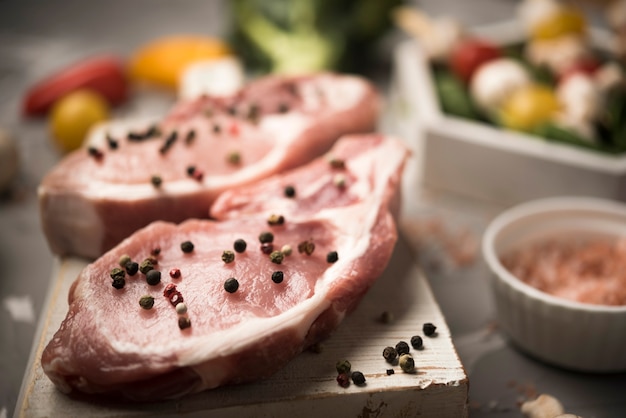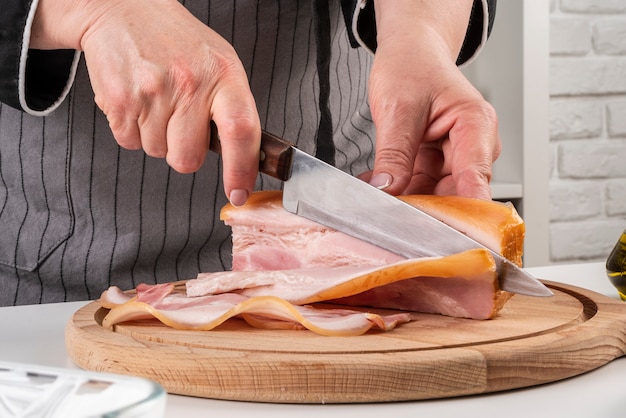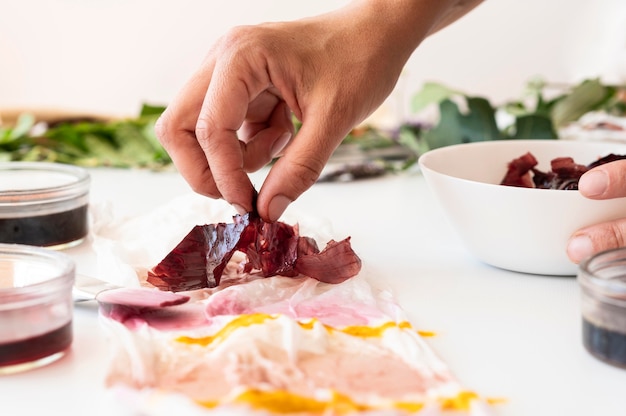You've got a pre-cooked ham in the fridge, and you're ready to enjoy it, but you're wondering how to reheat it without drying it out. Don't worry, you're not alone! Reheating a ham can seem tricky, but with a little know-how, you can achieve a perfectly juicy and flavorful ham that's sure to be a crowd-pleaser.
I've been there, myself! Over the years, I've learned a thing or two about reheating ham, from the classic oven method to the slow and steady approach of the slow cooker, and even the quick and easy microwave method for those times when you're short on time. Let's dive into the details together, and you'll be a ham-reheating pro in no time.
(Part 1) The Basics of Reheating a Precooked Ham

You might think, "It's already cooked, why bother reheating?" Well, it's not just about warming it up. Reheating helps to reactivate those delicious flavors and bring them to life. Imagine that beautiful smoky aroma filling your kitchen, and that melt-in-your-mouth texture that'll have everyone asking for seconds.
So, we're not just talking about temperature here, we're talking about enhancing the flavor and texture of your ham.
Understanding the Importance of Reheating
When you reheat a ham, you're not simply warming it up. You're essentially re-introducing moisture and heat to the ham, allowing the flavors to develop and meld. This process can turn a plain, pre-cooked ham into a delicious, flavorful centerpiece for your meal.
Think of it like this: when you bake a cake, you don't just throw it in the oven and pull it out. You let it bake for a certain amount of time, allowing the heat to penetrate the batter, create a lovely crust, and develop the flavors. Reheating a ham is similar; it's about giving those flavors time to develop and reach their full potential.
Choosing the Right Reheating Method
The method you choose depends on a few factors: the size of your ham, how much time you have, and the desired outcome. For a large ham and a grand feast, you'll probably want to go with a slow and low oven method. But if you're just reheating a few slices for a quick lunch, the microwave might be the quickest and easiest option.
We'll explore each method in detail, so you can choose the one that best suits your needs.
(Part 2) Oven Reheating: The Classic Method

The oven is a classic method for reheating a ham, especially for larger hams. It allows for even heating, and you can add a delicious glaze or basting to enhance the flavor.
The Oven Reheating Process
Preheat your oven to 325°F (160°C). Grab a roasting pan large enough to fit your ham comfortably, and line it with aluminum foil. Place the ham in the pan, skin side up, and pour a cup of water into the bottom of the pan. This creates steam that helps to keep the ham moist while it reheats. Cover the pan with the foil and bake for about 15-20 minutes per pound of ham, or until the internal temperature reaches 140°F (60°C).
If you're looking for a crispy skin, you can remove the foil for the last 15 minutes of baking. The skin will get nice and crisp, offering a delightful contrast in textures to the juicy ham.
Tips for Oven Reheating
Here are a few extra tips to ensure your oven reheated ham is perfect:
- Use a meat thermometer to check the internal temperature. This is the most reliable way to ensure the ham is cooked through and safe to eat. You want the thickest part of the ham to reach 140°F (60°C).
- Get creative with glazes! You can brush the ham with a honey mustard glaze, a brown sugar glaze, or even a simple maple syrup glaze during the last 15 minutes of baking for added flavor and a beautiful sheen.
- Let the ham rest for about 10 minutes after baking before carving. This allows the juices to redistribute, ensuring that your ham is juicy and flavorful.
(Part 3) Slow Cooker Reheating: The Low and Slow Approach

If you've got time on your side, the slow cooker is a wonderful way to reheat a ham. It's gentle, forgiving, and produces a melt-in-your-mouth texture. It's perfect for larger hams and those who want to ensure a perfectly moist result.
The Slow Cooker Reheating Process
Place your ham in the slow cooker, skin side up. Pour a cup of water or broth into the bottom of the cooker. Cover and cook on low for 4-6 hours, or on high for 2-3 hours. Allow the ham to simmer gently until it's heated through and the flavors have melded. You can add some seasonings, like garlic powder, onion powder, or paprika, or a glaze during the last hour of cooking.
Tips for Slow Cooker Reheating
Here are a few tips to enhance your slow cooker reheating experience:
- Choose a slow cooker that's large enough to accommodate your ham comfortably. You don't want it to be crowded.
- For added flavor, consider using chicken broth or apple cider instead of water. It will infuse the ham with a deeper, richer taste.
- Get creative with herbs! A few cloves of garlic, a sprig of rosemary, or a bay leaf can add a wonderful depth of flavor to your ham.
(Part 4) Microwave Reheating: The Quick and Easy Option
The microwave is a lifesaver when you're in a hurry. It's not ideal for a whole ham, but it's perfect for reheating individual slices or smaller portions. Remember, microwaves can heat things unevenly, so be careful and watch closely.
The Microwave Reheating Process
Place your slices of ham on a microwave-safe plate. Cover the plate with a microwave-safe cover or a damp paper towel. This will help to prevent the ham from drying out. Microwave on high for 30-60 seconds per slice, or until heated through. Check the ham frequently to ensure it's not overcooked.
If you're reheating a whole ham in the microwave, try to cut it into smaller portions before microwaving, for more even cooking.
Tips for Microwave Reheating
Here are some extra tips for microwaving your ham:
- Avoid using metal cookware in the microwave, as it can spark. Stick to microwave-safe dishes or bowls.
- Always use a microwave-safe cover or a damp paper towel to prevent the ham from drying out.
- Check the ham frequently to ensure it's not overcooked. It's easy to overcook ham in the microwave, so keep a close eye on it.
(Part 5) Stovetop Reheating: The Speedy and Simple Approach
The stovetop is a quick and easy way to reheat ham, especially if you're only reheating a few slices for a snack or a quick lunch. You can also get creative on the stovetop, adding a sauce or glaze to enhance the flavor.
The Stovetop Reheating Process
Heat a large skillet over medium heat. Place your ham slices in the skillet and cook for 2-3 minutes per side, or until heated through. You can add a little butter or oil to the skillet to prevent the ham from sticking.
If you want to add flavor, you can add a splash of honey, mustard, or maple syrup during the last minute of cooking.
Tips for Stovetop Reheating
Here are a few tips to make your stovetop reheating experience even better:
- Use a skillet that's large enough to accommodate your ham slices without overcrowding. You want them to have room to cook evenly.
- Don't overcook the ham, as this can make it dry and tough. Keep a close eye on it and remove it from the heat as soon as it's heated through.
- Feel free to experiment with different flavors. You can add a touch of garlic, a sprinkle of herbs, or a splash of soy sauce for extra zest.
(Part 6) The Importance of Temperature
When it comes to reheating ham, temperature is crucial. You want to ensure that your ham is heated to a safe internal temperature to kill any harmful bacteria that might be present. This guarantees a delicious and safe meal.
The Safe Internal Temperature for Reheated Ham
The USDA recommends an internal temperature of 140°F (60°C) for reheated ham. This means that every part of the ham should reach this temperature. Use a meat thermometer to check the temperature in the thickest part of the ham, making sure it's evenly heated throughout.
Why Temperature Matters
It might be tempting to skip the temperature check, but it's essential for food safety! Reheating ham to the correct temperature eliminates any bacteria that may have survived the initial cooking process. Always err on the side of caution, and if you're not sure, reheat it for a bit longer to be safe.
(Part 7) Leftovers and Storage
We've all been there: a delicious ham feast, and then you're left with a mountain of leftovers. But don't worry, you can enjoy your ham for days to come with proper storage techniques.
Storing Leftovers
The best way to store leftover ham is in an airtight container or wrap it tightly with plastic wrap. This keeps the ham fresh and prevents freezer burn or dryness. You can store it in the refrigerator for 3-4 days or freeze it for up to 2 months.
Reheating Leftovers
When reheating leftovers, you can use any of the methods we've discussed. Just make sure to bring the ham up to the safe internal temperature of 140°F (60°C). Whether you're using the oven, slow cooker, microwave, or stovetop, make sure to check the temperature to ensure safety.
(Part 8) Serving Suggestions
Now, you've got your beautifully reheated ham, but what to do with it? The possibilities are endless! Ham is incredibly versatile, making it perfect for a variety of meals and snacks.
Classic Ham Dishes
Here are some classic ham-based dishes that are always a hit:
- ham and cheese sandwiches: A classic for a reason! Combine a slice of ham, some cheese, and your favorite condiment on your favorite bread for a satisfying lunch or snack.
- Ham Salad: A delightful and easy lunch or appetizer. Combine chopped ham, mayonnaise, celery, onion, and seasonings. You can add some chopped hard-boiled eggs for extra protein.
- Ham and bean soup: A hearty and warming soup perfect for a cold day. Add ham, beans, vegetables, and broth to a pot and simmer until the flavors meld.
Creative Ham Dishes
If you're feeling adventurous, you can get creative with your ham:
- Ham and Pineapple Pizza: A sweet and savory combo that's always a crowd-pleaser.
- Ham and Asparagus Quiche: A sophisticated and elegant dish perfect for brunch or a light dinner.
- Ham and Potato Hash: A hearty and comforting dish that's perfect for breakfast or lunch.
FAQs
Let's address some of the most common questions about reheating ham:
Q: Can I reheat a ham more than once?
A: While it's generally safe to reheat a ham once, it's not recommended to reheat it multiple times. Each time you reheat it, the quality of the meat deteriorates, making it drier and less flavorful. It's best to enjoy it within a few days of reheating for the best results.
Q: Can I eat leftover ham cold?
A: Absolutely! Cold ham is delicious and a great option for sandwiches, salads, or simply enjoyed as a snack. It's a versatile ingredient that can be enjoyed hot or cold.
Q: Can I reheat ham in the crockpot?
A: Yes, you can! A crockpot is a great way to reheat ham slowly and evenly, keeping it moist and flavorful. It's a great option for larger hams or if you want a slow and gentle reheating process.
Q: How long does a pre-cooked ham last in the refrigerator?
A: A pre-cooked ham can last in the refrigerator for 3-4 days after opening. However, for optimal freshness, it's best to use it within that timeframe. Remember to store it properly in an airtight container to keep it fresh.
Q: What's the best way to reheat a spiral-sliced ham?
A: You can reheat a spiral-sliced ham using any of the methods we've discussed. However, since it's already sliced, you might want to use the oven or slow cooker to ensure even heating. These methods will allow the heat to penetrate the ham more evenly, preventing any parts from becoming overcooked or dry.
Table of ham reheating methods
| Method | Time | Temperature | Advantages | Disadvantages |
|---|---|---|---|---|
| Oven | 15-20 minutes per pound | 325°F (160°C) | Even heating, moist texture, allows for glazes | Can take longer than other methods |
| Slow Cooker | 4-6 hours on low, 2-3 hours on high | Low and slow heating | Very tender and flavorful, ideal for large hams | Can take a long time |
| Microwave | 30-60 seconds per slice | High | Quick and easy, ideal for smaller portions | Can overcook and dry out, not ideal for large hams |
| Stovetop | 2-3 minutes per side | Medium heat | Fast and simple, allows for glazes and additional flavors | Not ideal for large hams, can be prone to uneven heating |
With these tips and tricks, you'll be able to reheat your pre-cooked ham to perfection, ensuring a delicious and satisfying meal that everyone will enjoy.
Everyone is watching

How to Cook Frozen Lobster Tails Perfectly: A Step-by-Step Guide
RecipesLobster. Just the word conjures up images of lavish meals, special occasions, and a taste of luxury. But let's...

Pigs in a Blanket Cooking Time: How Long to Bake for Perfect Results
RecipesAh, pigs in a blanket. Just the name conjures up images of those delightful little parcels of crispy pastry en...

Pork Fillet Cooking Time: How Long to Cook It Perfectly
RecipesPork fillet, or tenderloin as it's sometimes called, is a real favourite in our house. It's so versatile, and...

The Ultimate Guide to Cooking Delicious Frankfurters
RecipesLet's face it, we all love a good frankfurter. It's a classic, simple, and always satisfying. But let's be rea...

Wolf Meat Recipes: A Guide to Cooking Wild Game
RecipesLet's be honest, you don't see wolf meat at your local butcher shop every day. It's a bit of a wild card, but ...
